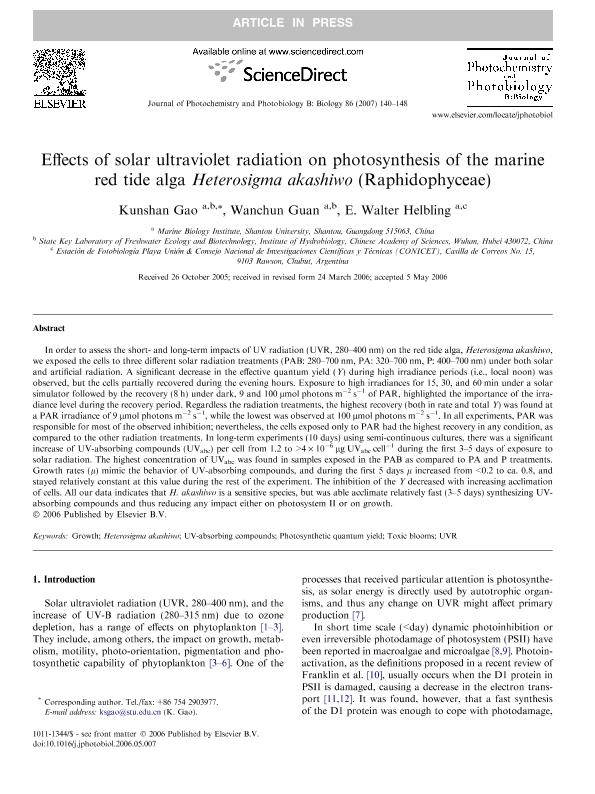Artículo
Effects of solar ultraviolet radiation on photosynthesis of the marine red tide alga Heterosigma akashiwo (Raphidophyceae)
Fecha de publicación:
02/2007
Editorial:
Elsevier Science Sa
Revista:
Journal of Photochemistry and Photobiology B: Biology
ISSN:
1011-1344
Idioma:
Inglés
Tipo de recurso:
Artículo publicado
Clasificación temática:
Resumen
In order to assess the short- and long-term impacts of UV radiation (UVR, 280–400 nm) on the red tide alga, Heterosigma akashiwo, we exposed the cells to three different solar radiation treatments (PAB: 280–700 nm, PA: 320–700 nm, P: 400–700 nm) under both solar and artificial radiation. A significant decrease in the effective quantum yield (Y) during high irradiance periods (i.e., local noon) was observed, but the cells partially recovered during the evening hours. Exposure to high irradiances for 15, 30, and 60 min under a solar simulator followed by the recovery (8 h) under dark, 9 and 100 lmol photons m2 s1 of PAR, highlighted the importance of the irradiance level during the recovery period. Regardless the radiation treatments, the highest recovery (both in rate and total Y) was found at a PAR irradiance of 9 lmol photons m2 s1, while the lowest was observed at 100 lmol photons m2 s1. In all experiments, PAR was responsible for most of the observed inhibition; nevertheless, the cells exposed only to PAR had the highest recovery in any condition, as compared to the other radiation treatments. In long-term experiments (10 days) using semi-continuous cultures, there was a significant increase of UV-absorbing compounds (UVabc) per cell from 1.2 to >4 · 106 lg UVabc cell1 during the first 3–5 days of exposure to solar radiation. The highest concentration of UVabc was found in samples exposed in the PAB as compared to PA and P treatments. Growth rates (l) mimic the behavior of UV-absorbing compounds, and during the first 5 days l increased from <0.2 to ca. 0.8, and stayed relatively constant at this value during the rest of the experiment. The inhibition of the Y decreased with increasing acclimation of cells. All our data indicates that H. akashiwo is a sensitive species, but was able acclimate relatively fast (3–5 days) synthesizing UVabsorbing compounds and thus reducing any impact either on photosystem II or on growth.
Archivos asociados
Licencia
Identificadores
Colecciones
Articulos(SEDE CENTRAL)
Articulos de SEDE CENTRAL
Articulos de SEDE CENTRAL
Citación
Gao, Kunshan; Guan, Wanchun; Helbling, Eduardo Walter; Effects of solar ultraviolet radiation on photosynthesis of the marine red tide alga Heterosigma akashiwo (Raphidophyceae); Elsevier Science Sa; Journal of Photochemistry and Photobiology B: Biology; 86; 2; 2-2007; 140-148
Compartir
Altmétricas




